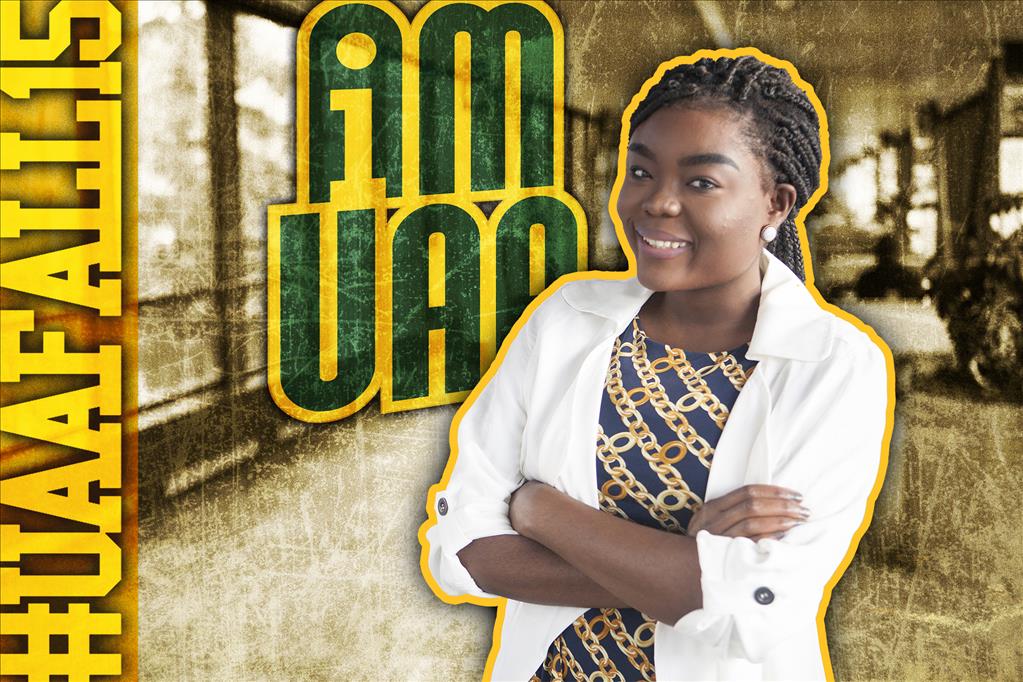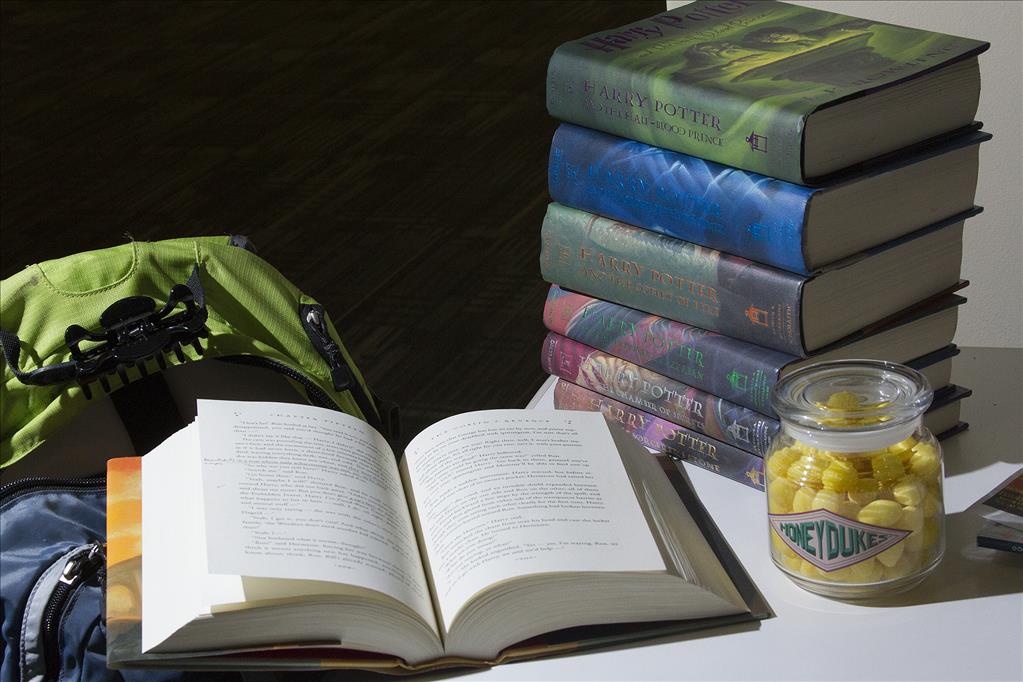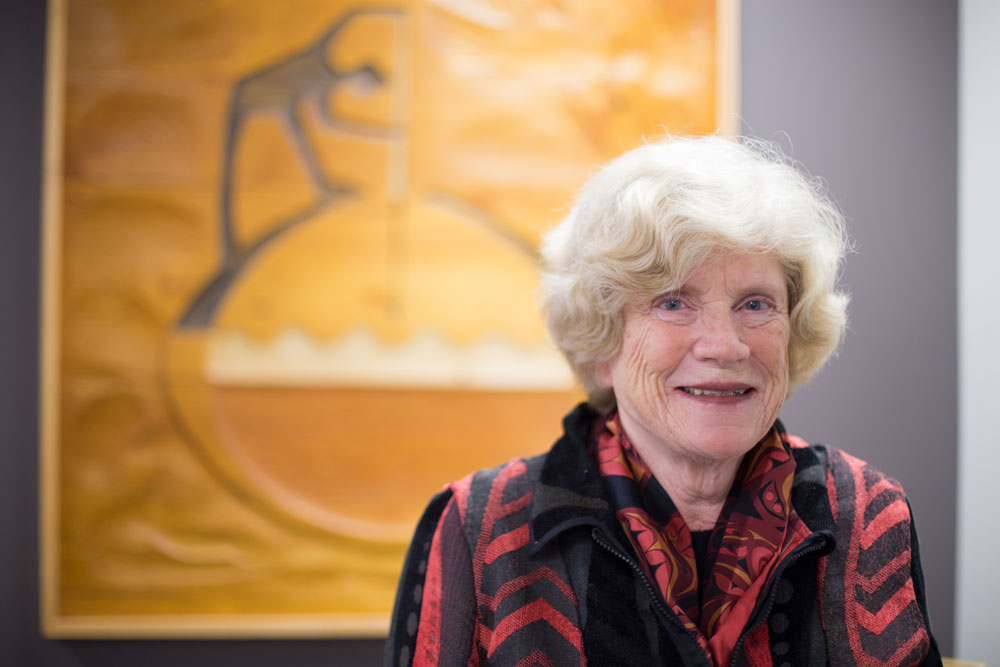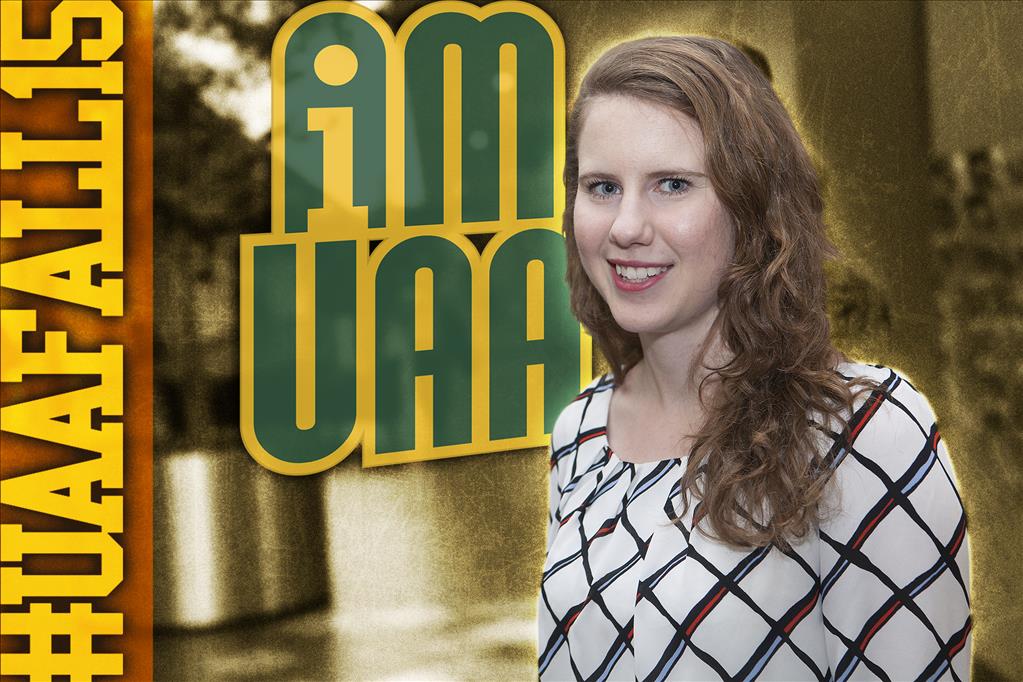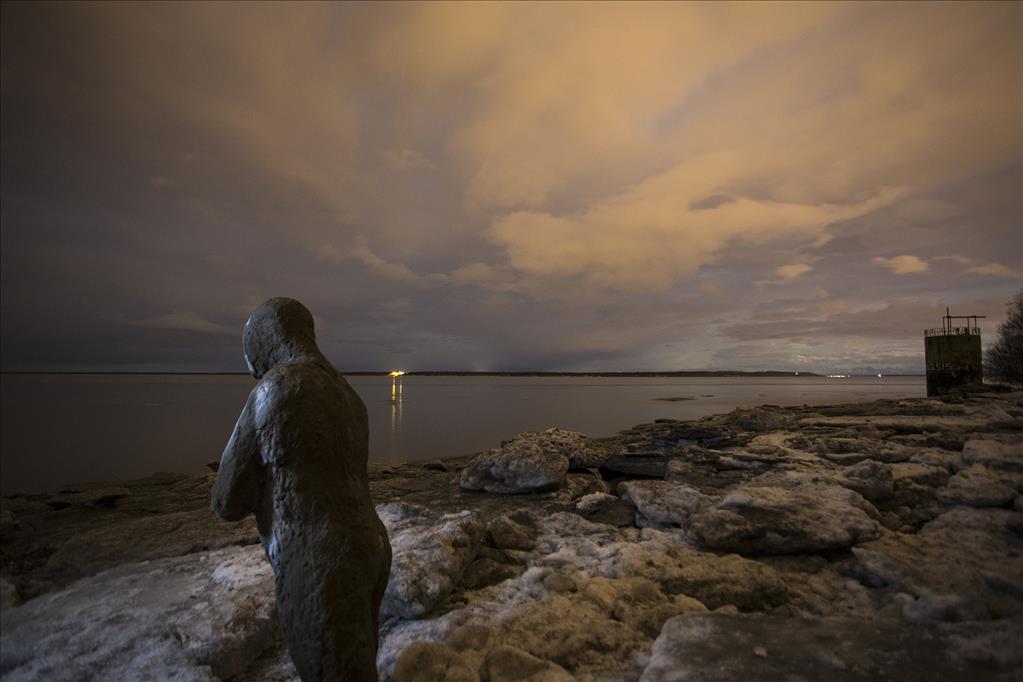The raft pack
by joey |
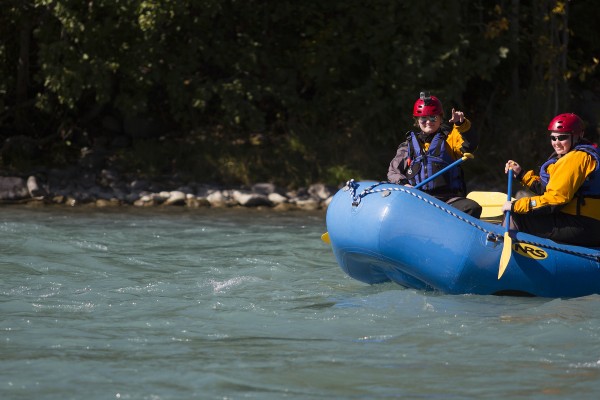
Outdoor leadership student Monica Fleming rides a wave train down the Kenai River with her beginning river rafting classmates. (Photo by Philip Hall / University of Alaska Anchorage)
On a sunny morning in late August, a group of UAA students arrived at the Cooper Landing put-in on the Kenai River. Dressed in full-body orange and yellow drysuits, they marched toward the water looking like members of a nautical Starfleet. Helmets in place and safety talk complete, they clambered into the rafts with their professors and set off down the steely-blue waters for class.
Beginning river rafting is yet another incredible course offering provided by the Department of Health, Physical Education and Recreation (HPER). Each year, the rafting course kicks off the school year, condensing an entire 1-credit class into the first seven days of fall semester. On Monday, the students meet in the classroom to go over equipment, rafting terms, how to read the river and other essentials. On Wednesday, they paddle around in a controlled environment (typically the UAA pool), and Friday through Sunday, it's a three-day rafting adventure complete with campfires, taco nights and plenty of paddle time.
https://www.youtube.com/watch?v=MbdjTISJ-VM
Experiential education
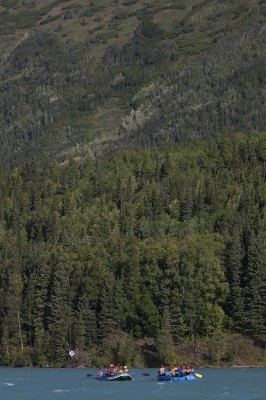
The Kenai mountains dwarf UAA's rafting students on their three-day field trip with the Department of Health, Physical Education and Recreation. (Photo by Philip Hall / University of Alaska Anchorage)
River rafting is a wet and wild step on the way to graduation for outdoor leadership students but, like all physical education classes, the course is open to everyone. HPER courses are a great intro to Alaska adventures and the department provides students with all the gear they'll need-paddles, life jackets, dry suits and, oh yeah, two 14-foot rafts. Each adventurous class comes with two industry experts who also happen to be UAA faculty-in this case, HPER director T.J. Miller and adjunct professor Gavin Vaughan.
As you can expect, the teaching style is a little different in physical education. "This could possibly be students' first-time exposure to experiential education," said Gavin, who also teaches beginning sea kayaking in October. "They get some lecturing, but if you came to one of my or T.J.'s classes, the opening activities we do are already about forming the community. We don't go right into a lecture; there's some foundation-building first."
In addition, Gavin cited the value of HPER classes for those looking to make the most of the state. "I think for folks new to Alaska, it can be a little bit intimidating to get outside," he explained. "Here, you have instructors that are patient and willing to work with people of all abilities and show them that they can do it."
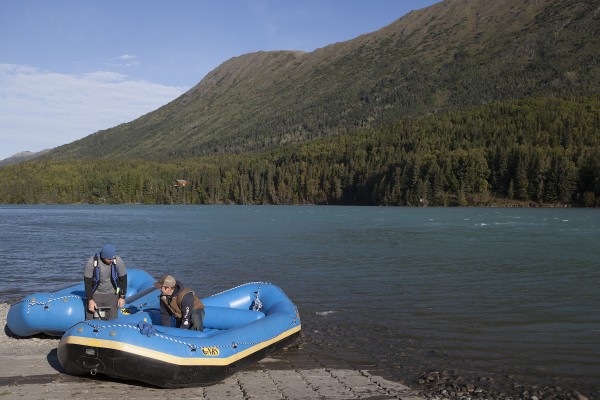
Students inflate the rafts in the early morning at Cooper Landing. Alec Dockter, right, is a North Dakota native on a one-year exchange at UAA. (Photo by Philip Hall / University of Alaska Anchorage)
Whitewater weekend
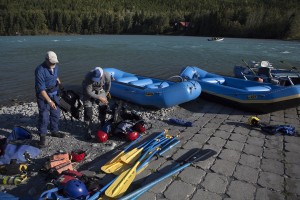
Professors Gavin Vaughan, left, and T.J. Miller set out the gear for students at the start of the day. (Photo by Philip Hall / University of Alaska Anchorage)
After establishing foundations in Anchorage, the students were ready for a weekend on the water. Each day started on a new river, and each river included two runs. Students switched between rafts-one equipped with a crew of paddlers, one powered by a sole central oarsman-and even got the chance to swim the icy rapids (supervised) on the first day. Afternoon lunch breaks were spent at historic riverside cabins or out in the water catching passing salmon with bare hands. At the end of the day, with hawks diving through the trees and the red flash of salmon surfacing in the current, students pulled into the boat launch, broke down the rafts, hoisted them out of the water and belted them to the racks with enough speed and synchronicity to turn a few fly fishermen's heads. Then, it was back to the campsite.
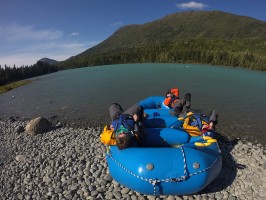
Students take a break between runs on the Kenai River. (Photo by Philip Hall / University of Alaska Anchorage)
The first day, students eased into rafting on the wide Kenai River, which provided just enough volume and just enough whitewater to get a good taste of the days ahead. With plenty of room to maneuver, the Kenai served as an excellent testing ground for reading the river and practicing essentials like ferry angles-the direction of the boat relative to flow that keeps the paddler in control.
But it was still no picnic. The class started one day after a wind advisory hit the area. After some committed paddling to break free of the wide stretch at Cooper Landing, and with American flags on riverside cabins whipping in the wind, the class eventually reached the swift tide that carried them the rest of the way to the Russian River ferry.
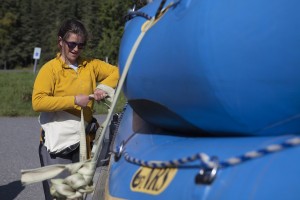
Andi Parrott belts down the boats after a day on the river. (Photo by Philip Hall / University of Alaska Anchorage)
After a night of camping (plus a community taco night), the students headed on to the Portage River on Saturday. "Portage is a small creek, but it's not raging, so they really have to be on their game," Gavin explained. With tight corners and narrow corridors, the Portage creek provided a next level of maneuvering.
But day three was the big test. Combining the Kenai's swift currents, the Portage's sweeping corners and a steeper topography all its own, the Matanuska River provided varsity-level paddling. After a night in Anchorage (and a chance to change out wet socks), the students met on campus for one last early morning, setting off for Chickaloon in a big UAA bus. Rapids are controlled by three elements-volume, gradient and constriction-and the volume of the Matanuska is nearly always gushing. "You really have to be on your ferry angle game and it's moving twice as fast," T.J. said of the Matanuska. "It moves."
Thankfully, by Sunday, students were ready to ride the wave trains and pull into the final eddy at the boat launch to cap off an epic weekend in class.
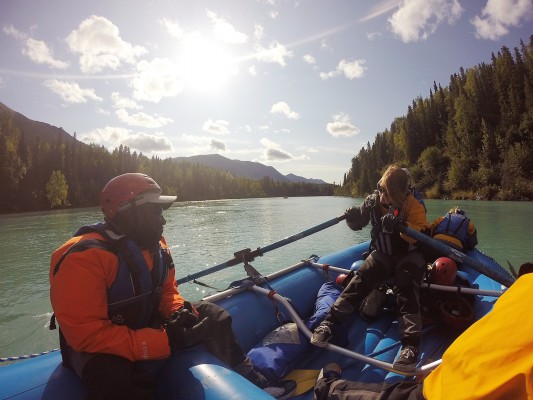
Journalism major Kelly Ireland steers the ship through a stretch of still water on the Kenai. (Photo by Philip Hall / University of Alaska Anchorage)
"People don't know what they're missing"
There were just enough students to fill two boats, and each had their own valuable reason for taking the class. Some enrolled to face their fears in a safe environment. Others were there for the thrill ride. There were Army vets and Navy vets, journalism majors and aspiring dog mushers, plus students who recently arrived from Norway and North Dakota (where, the student joked, "the highest point around is probably the trees").
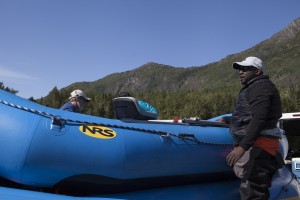
Social work major Proctor René breaks down the rafts at the end of day 1. (Photo by Philip Hall / University of Alaska Anchorage)
Proctor René, a social work major, has been working toward an outdoor leadership minor since he first discovered backpacking was an annual course offering. "I didn't even check it, I just clicked on it," he laughed. Since that trip-including a snow-filled weekend in the wilderness-Proctor couldn't get enough of the HPER department. "I got hooked on it. T.J.'s such a great instructor. He just sucks you in. I loved the class, I love the department, I love the minor," he said.
But all these adventures have a purpose. He hopes to find a career in outdoor therapy after graduation, one that recognizes nature as a vital destressor. For him, outdoor leadership connects to social work "in a major way," especially if he wants to work in Alaska. "It fit perfectly with social work," he said.
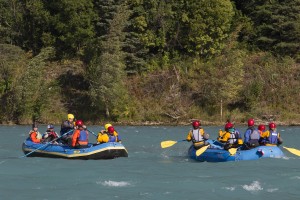
Students ran each river twice, swapping between a boat equipped with oars and one with paddles. Professional piloting major Jesse Munday commandeers the oars in the boat on the left. (Photo by Philip Hall / University of Alaska Anchorage)
Jesse Munday, another outdoor leadership minor, also has a unique take on the class. When he graduates with a professional piloting degree, he'll have his flying rating from the aviation department and several Level 1 certifications from HPER. "I think everything that I'm learning in this class makes me more marketable," he said. "A lot of the stuff we learn is a really good résumé-builder." But then again, the element of fun can't be overlooked. "I fell in love with the state and moved up here for stuff like this," he said, looking out over the Kenai River. "I don't do a lot of this stuff on my own, so taking these classes is a good excuse to get out."
He also finds that many of his classmates have never heard of these courses, especially when he tells them he went backcountry skiing for class. "I really enjoy classes with T.J. He really knows his stuff and all the people he works with are always really professional," Jesse added. "I really think a lot of people don't know what they're missing."
Next adventures
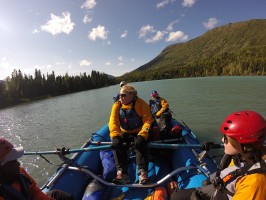
Social work major Adrianna Simonson navigates the Kenai River. (Photo by Philip Hall / University of Alaska Anchorage)
Following the weekend, the class met one last time in the classroom in Short Hall to recap all they'd learned. Sunburned but energized, they reviewed the generals (how to pack and dress for the outdoors) and the specifics (whether hypalon or urethane rafts are sturdier, and which are easier to repair in the field). Though no one was fixing to sign on as a raft guide that night, everyone was now prepared to plan, scout and pack for his or her own weekend adventures. As an extra incentive, T.J. told the class which local shops give his students discounts on raft rentals.
"It was beautiful outside," social work student Adrianna Simonson said, recapping the blue-sky weekend. For her, the highlights included the perfect rivers, group camaraderie and the knowledge that, if they got in a bad situation, two friendly experts were immediately on hand. "It was a fun class and I'm glad I took it."
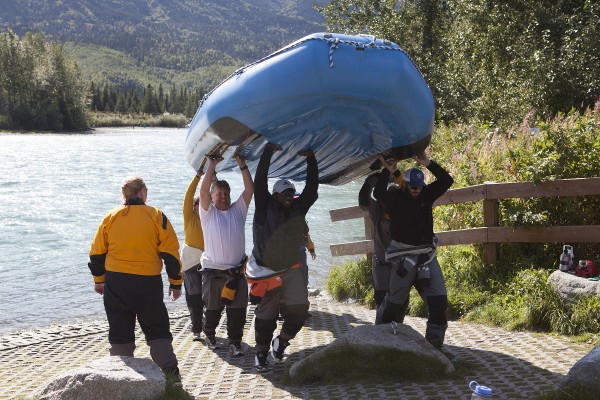
Students lift the raft out of the river before heading back to the campsite for the night (Photo by Philip Hall / University of Alaska Anchorage).
Written by senior rafting correspondent J. Besl, UAA Office of University Advancement
 "The raft pack" is licensed under a Creative Commons Attribution-NonCommercial 4.0 International License.
"The raft pack" is licensed under a Creative Commons Attribution-NonCommercial 4.0 International License.










